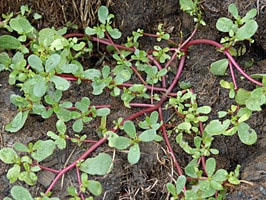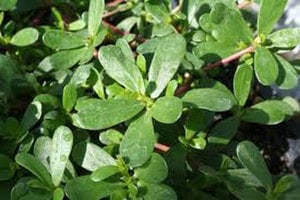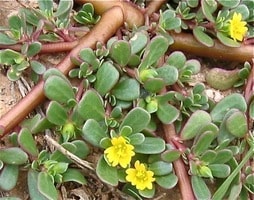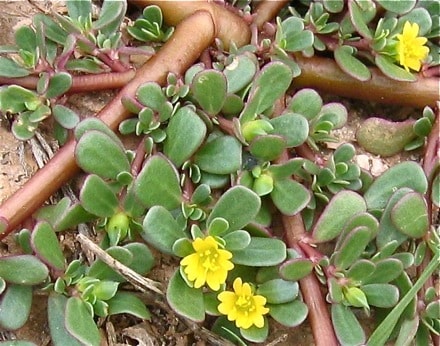




Also called pigweed. Grows everywhere. Very commonly seen in cracks in the sidewalk. Also grows among woodchips. Comes out in June. Best to harvest in the fall. This is when the plants are large. Has small dark seeds that fall out. Harvest in the morning. Nutritional content varies, depending on what time of the day it was harvested. Cultivated and eaten in Greece. Good in tabbouleh, on gyros and eaten with feta. Tastes like green beans. Very important – purslane is reported to be the highest plant source of Omega 3.
Also known as pineapple weed, wild chamomile grows in rocky soil and is seen commonly in driveways. It’s very aromatic. I can smell it when the wind picks up and follow the smell to the chamomile. It’s commonly made into tea and it’s good for digestion, nervousness, anxiety, irritability; it helps to calm and soothe you and it helps you sleep. Chamomile is so safe and mild it is used on children and babies.
Emerges in spring. By June the plants are quite large. If there is an extended growing season, (warm weather into the fall and winter) there can be a second resurgence. This plant is more of a medicinal herb than food, although it can be used in place of traditional mint in any recipe. It’s very aromatic. The smell is dissimilar to mint found in grocery stores and distinctive. Use its smell to identify it. It grows in shady areas, under trees and other large plant growth. In cats, catnip is a stimulant and in humans it’s a sedative. Catnip tea can be good for allergies and the respiratory system. Some studies say catnip repels fleas and ticks better than DEET. This plant can help induce menstruation. Pregnant women should be cautious. In large quantities catnip can be an abortifacient.
Woodsorrel has a sour and lemonly flavor. It can make a good substitute for lemon in dishes. Looks like clover but is brighter and has small, yellow flowers. I see it growing a lot among woodchips, but I don’t think it’s particulaly picky about where it grows. A naturopath once told me it was good for the liver, but only when fresh. Not when dried.
Mulberries typically ripen in July, but some are ripe right now (June 2015). They make for simple and abundant urban foraging. Mulberries come in black, purple, red, pink and white. Black / purple mulberries are ripe. Red ones are unripe. Pink / white mulberries are a different kind of mulberry. They are sweetest and they are creamy. Dr. Oz called white mulberries the newest health sensation and I have seen them sold dried in superfood powder. Mulberries don’t ship well and are highly perishable. You will not see them on grocery store shelves because of this. Don’t let that deter you. Mulberries can make for great eating.
Very common and abundant. Grows everywhere. Slightly thorny and has bent-over branches. Be cautious of the thorns. The plant grows in the form of a half circle. The leaves can be made into an herbal tea, and they are around spring, summer and fall. The young leaves in the spring are best for tea. When the leaves get older they contain a toxin. The berries are ripe in June and they fight colon cancer. Jo Robinson’s book Eating On The Wild Side states that black raspberries are healthier than all of the berries sold at the supermarket. So if you’re interested in a very healthy berry, black raspberry is a wonderful choice. Her book also says wild blueberries are a healthy choice – if you live near acidic soil.
As common as it comes. Brought here by Europeans. Edible and medicinal. The most nutritious thing I have ever heard of. Fights inflammation in the intestine - from carrageenan for example. Detoxifies. Purifies blood. If you have a bee sting, take a piece of plantain, chew it and then place it on your wound. Good for blisters. Speeds healing. Natural Awakenings named them (and dandelion) in a piece about herbs that fight cancer. It can also help with psoriasis.
Similar to a radish. Spicy and clean flavor. Grows near streams, creeks, pure running water and can grow in mud. Watercress is only as clean as the water it grows in. Boil or sanitize if at all questionable. High in vitamin C. Good for soups, salads, you name it. The wild variety is the same as the kind you can buy at the grocery store, except it is free.
There are male and female trees. Only the female trees make the fruit and the gingko nut, which can be eaten. The fruit is not eaten. The popular ginkgo biloba supplement is made out of the leaves. When harvesting ginkgo nuts, gather the fruit. Remove the fruit using gloves (some people get a rash when touching the fruit, some do not) Wash and then cook the nut. Boil, fry, sauté. Whatever you like. When cooked, the shell will remove easily. The cooked ginkgo nut looks an awful lot like a pistachio and you can put it in your mouth and between your teeth to crack then remove the shell, just as you would with a pistachio. The inside is green and reminiscent of a jelly bean. Ginkgo biloba is very nutritious, but also has toxin. They must be eaten in moderation. Taking vitamin B6 with gingko cancels out the toxin. (Still – eat in moderation!!!) Do not eat ginkgo nuts raw. Eating the nuts raw is unheard of. It is hoped the cooking process will eliminate toxins, but there is little evidence to suggest it does. In spite of this, cooking them is still your safest bet.
Young leaves and roots are edible. Found very often on roadsides and in open fields. Comes out in the height of summer, along with echinacea. The root can be made into a coffee substitute and leaves can be enjoyed as a salad green. (There is a variety of chicory grown for its leaves.) The small blue flowers are beautiful, delicate and rare.
The fruit, leaves, seeds and young vine shoots can be eaten. Dolmades are enjoyed in Greece (stuffed grape leaves). This is a very common weed! It grows on fences, trees and occasionally over the ground. The fruit is very similar to a concord grape. The grapes (fruit) ripen in the fall and can be harvested until November. The fruit is much smaller than what you would find at the grocery store, but it is unmistakable. After I harvest and wash grapes, I like to freeze them. They taste sweeter and creamier that way but not at all like a domesticated grape. They have large seeds. You should eat them. It is just as nutritious as eating grapeseed oil. The Virginia Creeper (Parthenocissus quinquefolia) is a lookalike you’ll want to avoid. In the fall it has bright red leaves and similar looking berries. They are not edible. They are very spicy.
Usually toxic and inedible. The toxin makes you starve to death / waste away. One you’ll want to avoid. Some kinds are edible and can be enjoyed but it’s hard to distinguish the edible from inedible varieties. It’s just as hard to distinguish edible from inedible sweet peas as when foraging for mushrooms. So this is one that should only be undertaken if you’re an absolutely amazing forager and you really love peas and want free ones. Vetch is a look alike.
Related to mint. Can be eaten in salads and used to make tea. Abundant. Creeping charlie can be bad for other plants because it can wrap around the plants and choke them. Has purple flowers. Contains a toxin. Nutritious, but eat in moderation. Very commonly seen as wild ground cover.
One of the first plants to come out in the spring. Frost, snow and cold weather doesn’t seem to bother it. Invasive, originally from Eurasia. Bad for the environment (in Wisconsin). Grows everywhere. There are volunteers devoted to destroying and pulling this plant up. Take as much as you want. Edible raw but if you boil and change the water several times / eat garlic mustard this way, it will have a milder flavor. Also good when dried. It smells and tastes very strong. Reminiscent of garlic.
Emerges in spring. By June the plants are quite large. If there is an extended growing season, (warm weather into the fall and winter) there can be a second resurgence. A favorite of Shailene Woodley. She forages for stinging nettle then makes a tea. She takes it during menstruation. She also turns stinging nettle into tincture. Used for food as well as herbal medicine. Very stingy. Harvest with gloves, or you may get welts. Some say these are good for your immune system but many things are. No need to get stung in my opinion. Boil stinging nettle then serve. Nettles are nutritious and a good source of calcium as well as many other vitamins and minerals. There is a contest in the UK where contestants eat as much stinging nettle as they can. Whoever survives is the winner and the toughest / manliest. It’s very entertaining to watch.
Edible shoots and pollen. The pollen can be used to make pancakes. Very good in survival situations. The brown top can be used to carry an ember. The white, inner spear tastes faintly of watermelon and is the most fibrous food I have ever eaten. The fiber content makes them very good at cleaning teeth.
Growing all over downtown Janesville. Used as food and as medicine by Native Americans. Very mild and tasty. Almost buttery. Wonderful taste for a green vegetable. Not bitter at all. Called wild spinach and by many other names. Contains oxalates, as do spinach. A nutritional powerhouse, but the nutritional content depends on where you harvest it from. It can soak up nitrates from the soil it grows in. Quinoa is closely related to the seed of lambsquarters. The seed of lambsquarters is edible, but hard to harvest. Many people say it’s not worth the trouble. Don’t let that deter you from trying the seed at least once.
There is the wild rose and the cultivated variety. Rose hips are an easy find for the urban forager. There is scarcely a park or garden without rose bushes. The fruit of the rose, the rose hip, ripens in October. The rose hip is edible throughout the winter. This is intentional. Some plants are edible throughout the winter so hungry animals have something to eat. Rose hips are high in vitamin C, fiber and antioxidants. They boost the immune system and fight off colds. The outer hull of the rose hip is what is eaten. Some guides say the seeds are edible, some say they are not. I eat the entire rose hip, seeds and all. I grind and chew it very well, but they are prickly and hairy. They can cause irritation. I think it’s too much work to remove the seed, but the best / tastiest experience is to remove the seeds and eat only the outer hull. Miranda Kerr uses rose hip seed oil for beautiful skin. Rose petals are also edible, but strong tasting and for lack of a better word, bitter. Rose petals are often used to make rose water.
Comes out in spring, usually in March but can be April or May if there is an extended cold period / winter. Violets can be violet, magenta, white and yellow colored. The leaves, stems and flowers are all edible. Use in place of spinach in your favorite creamed spinach recipe. Delicious! The roots are used to induce vomiting. Violets are commonly topped with sugar. Candied violets are used in baking sweets, treats, and to top pastries. Violets are common, beautiful and grow low to the ground. They grow along with grass, dandelion and garlic mustard, which also grow close to the ground.
Elder flowers and berries are the only parts that are edible. Do not eat them raw. Boil or cook them first. Both are good for the immune system. If you harvest the flower, there will be no berries. Elderberries are popular among birds. Many times the birds will beat you to the berries. If you want to ensure you'll have a little for yourself, it may be best to harvest the flowers. Elderflower tincture is a popular cold remedy and one of the only things that alleviates the flu.
Echinacea is native to North America. It is found in prairie and grassland. It flowers in July along with chicory, during the height of summer. If you look for it late, you can find the cones without flower petals. These should be left because they contain the seeds, which create the next generation of echinacea. This is more of a medicinal herb than food. It is good for the immune system. The leaves, flower petals and root are used for herbal tea and tincture. A mild tingling feeling is experienced when drinking echinacea tea. It is unique and reminds me of being electrocuted.
Forage sparingly. Milkweed is of immense importance to monarch butterflies. Many plant it to attract butterflies to their garden. The shoots, flowers, green, unopened pods can all be eaten, but they must be boiled first. Milkweed is poisonous in its natural state. Discard the cooking water. The silk inside the young pods has a texture reminiscent of cheese. Once the growing season has passed, the dead stalks and seed pods still remain. These can be used to identify where new milkweed will appear.
Note: The pods must be harvested when they are less than 1.5 inches long. If you harvest them late, they are too fibrous to be eaten.
Chickweed is edible and medicinal. It is found all over the world, even in the Article Circle. Its blossoms open in the late morning. Its leaves fold up at night and before rain. Chickweed’s stems, leaves, flowers and seeds are all edible. Mouse-ear chickweed must be cooked. Other kinds can be eaten raw. It contains nitrates. Do not ingest any kind of chickweed preparation if pregnant or nursing. This could potentially harm an unborn or nursing child due to the nitrates it contains. One should consider the nitrate levels in the leaves. Upon consuming chickweed, if one feels dizzy, weak, or faint, if you have a headache, see a doctor immediately. You may have nitrate poisoning from consuming too many nitrates. Avoid chickweed if allergic to daises. Good when young as a salad green. Rumored to taste like corn silk raw. Tastes like spinach when cooked. Can be added to soups or stews. Do this in the last five minutes to prevent overcooking. Chickweed contains ascorbic-acid, beta-carotene, calcium, magnesium, niacin, potassium, riboflavin, selenium, thiamin, zinc, copper, and gamma-Linoleic acid. In addition, chickens love to eat chickweed. This is where chickweed got its name. Chickweed can be used in topical form to calm rashes and eczema, too. It alleviates irritation and swelling from insect bites. Chickweed is not recommended for children in oral form. It can be used to treat an insect bite on a child so long as they do not put chickweed in their mouth.
Includes notes from the June 2015 Foraging Walk at Rotary Gardens in Janesville. We're planning a wildcrafting class this fall - contact us if you're interested.